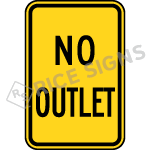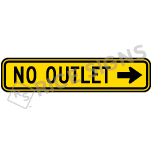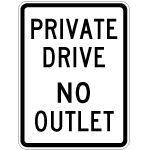No Outlet Signs
Commonly seen in neighborhoods, no outlet signs help drivers find the correct route.
About No Outlet Signs
What is a No Outlet Sign, and how are they used?
A No Outlet Sign signals that a road or collection of roads has one overlapping entrance and exit. This type of warning sign can commonly be seen at the entrance of a residential neighborhood that contains a cul-de-sac. No Outlet Signs are intentionally placed in highly visible locations so that drivers have ample time No Outlet Signs are intentionally placed in highly visible locations so that drivers have ample time to take a different route, if they so choose (MUTCD 2C.24, 01).
The most common No Outlet Signs are listed below
Click the item for more information
Selecting a No Outlet Sign
What No Outlet Sign sizes do you offer?
We offer four sizes of our diamond-shaped signs: 24”x24”, 30”x30”, 36”x36”, and 48”x48” signs. 24-inch signs are limited to low-volume, residential roads. 30-inch signs are used on single-lane roads, while multi-lane roads and highways use 36-inch signs. 48-inch signs are considered oversized and provide additional visibility. We also offer 36”x9” flat and extruded blades for street name blade No Outlet Signs.
All versions of the sign are made using high-quality materials that carry a minimum 10-year warranty against fading or loss of reflectivity. High intensity prismatic reflective sheeting is the base level that meets the minimum standards in most jurisdictions. The Fluorescent Yellow Prismatic is the most reflective version of the No Outlet sign.
Should I choose the street name blade No Outlet Sign or the diamond-shaped No Outlet Sign?
Street name blade No Outlet Signs feature a horizontal arrow pointing to the left or to the right. When one of these signs is mounted with street name signs at intersections, the arrow should point toward the no outlet road. Diamond-shaped No Outlet Signs, not street name blade signs, must be used when road traffic is flowing straight ahead into the no outlet road. It is common to use both the street name no outlet sign and the traditional W14-2 traffic sign together.
What’s the difference between a “No Outlet” sign and a “Dead End” sign?
No Outlet Signs are used where one or multiple upcoming roads have one combined entrance and exit. They are commonly used at the entrance to a single road or road network from which there is no other exit. Dead End Signs mark one road that ends without any intersections. The MUTCD doesn’t provide specific guidance on when to use a No Outlet Sign vs. a Dead End Sign on a single roadway, but the manual generally allows road engineers to use their professional judgment.
Mounting Signs
How do I mount a No Outlet Sign?
Use any round, square, or U-channel post to mount a diamond-shaped sign. 48”x48” signs have four pre-punched holes and require two sign posts. Use a 5.5” or 12” slot street sign bracket to mount a street name blade sign.
More Information
Where can I find more information about No Outlet Signs?
Chapter 2C, Section 2C.24 of the MUTCD provides a comprehensive overview of this sign category.

 MUTCD W14-2
MUTCD W14-2 
 MUTCD w14-2a
MUTCD w14-2a  PR163
PR163 PR162
PR162